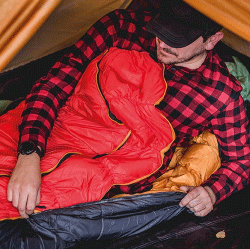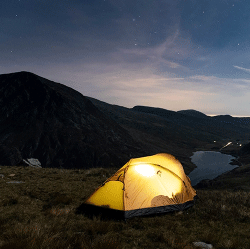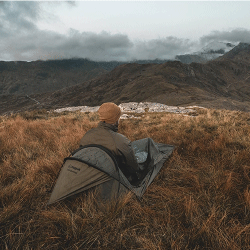

So You Want To Wild Camp With The SNUGPAK® STRATOSPHERE..?
Wild camping in the UK is both incredibly satisfying and an essential skill when moving into remote environments in a variety of difficult and dangerous terrain, regardless of weather or time of year. Lightweight wild-camping is a stalwart skill for alpine mountaineering, adventure racing or any venture where the threat of benightment is a real possibility.
Here are Snugpak’s Top Ten Tips for Wild Camping using the lightweight Stratosphere:
1. Always remember the 1,2,3,4 System…
2. Know the Law;
3. Plan Ahead: Pitch at Sunset, Strike at Sunrise;
4. Use the correct Tent Pegs;
5. Carry an Absorbent Towel, or a small Kitchen Sponge;
6. Don’t leave home without…
7. Invest in a Quality Synthetic Sleeping System;
8. Practice, practice, practice!
9. Balance Comfort Vs. Weight;
10. Spend a Weekend on Dartmoor.
The 1,2,3,4 System:
Developed by Snugpak as an easy reminder for wild campers, the 1-2-3-4 System will help you with a good nights sleep:
- One Good Nights Sleep requires;
- Two points of access…
- Three working areas…
- Four dimensional safety.
Whether intentional wild-camping, creating a forced bivouac or doing the best you can for an emergency benightment, being prepared and planning ahead ensures that you can achieve a good nights sleep regardless of environment, terrain and weather.
When setting up camp, ensure that you haven’t backed yourself into a corner or area from which you can’t escape in an emergency. Have two points of access, normally in the direction of travel. This is of particular importance when camping in valleys, or in mountainous terrain. In the event of an emergency, can you egress from your campsite in more than one direction?
Your campsite, no matter how small, needs three distinct areas: The main area in which you will pitch your tent or bivouac; a cooking and administration area, making sure the risk of a tent fire is kept to the absolute minimum and finally a toilet area.
Remember to avoid areas close to water sources, and if you can’t carry out solid waste, bury it sufficiently so as not to affect other users – at least 50m from where you are camping; no one likes the smell of pooh in the morning!
Finally, think of your camp safety in four-dimensions. In winter months, considerable time can be spent in your tent from sunrise to sunset. Look up and down, left and right, forward and back, ensuring that your campsite location is safe. Remember to think in time as well; will your pitched tent be safe in an hour, through the night? What if the weather changes? Just because your campsite is safe now, as you prepare to sleep, consider what will happen throughout the night.
2. Know the Law:
Some National Parks allow wild camping, others have seasonal and blanket bans. Ultimately, wild camping is illegal and a form of trespass on private property, or tolerated if land is respected in parks and on trails.
Dartmoor National Park is unique for wild campers, and they have a map of areas where you can camp on common land, and the Brecon Beacons provide a list of farms that welcome campers.
Forced bivouacs and emergency benightment are unlikely to see you arrested; but know the guidelines for setting up camp properly.
In the Cairngorms and Loch Lomond and the Trossachs the Scottish Outdoor Access Code gives everyone the right to wild camp so long as you follow the guidelines.
Always check before you go!
3. Plan Ahead: Pitch at Sunset, Strike at Sunrise:
No one wants to be caught out, so plan ahead and arrive at your chosen camp with good time to spare, so you can eat well and enjoy that outdoor feeling. Set up your campsite just before last light, and strike the camp as soon as the sun rises.
In summer months your campsite may only be up for a few hours, where as in winter months, you could be enjoying 14 hours of sleeping bag time!
Your campsite should not be visible within the surroundings, unless it is an emergency or forced bivouac. This is why most tents that are used for wild camping are olive or forest green.
4. Use the correct Tent Pegs:
Make sure you have the correct tent pegs for the terrain you are camping in. Standard stakes are good for grass pitches on campsites, but the X-design may be better for intermediate terrain. Bigger pegs including a twisted design are good for peat or sandy areas. Lightweight carbon or titanium pegs are optionally, but lack the strength of conventional designs.
5. Carry an Absorbent Towel, or a small Kitchen Sponge:
Most of the condensation that appears overnight is moisture that YOU have brought into the tent or shelter system. An absorbent towel is ESSENTIAL for removing as much moisture from equipment before you zip up for the night, as well as drying kit off before you pack it away in the morning.
6. Don’t Leave Home Without:
The Essentials for repair! Always make sure you have the following, just in case:
- Medium Length Cable Ties;
- Small Roll of Duct Tape;
- Spare Lines, or invest in some 550D Paracord;
- Some small lengths of 3-4mm Bungee Cord;
- Superglue;
- Small Pen Knife;
- Manufacturer’s Repair Kit (If Supplied).
7. Your Sleeping System:
Regardless of whether you are camping in a tent of under a Tarp, make sure your sleeping system is up for the task in hand. Remember, there are 3 components to your sleeping system, not including your shelter:
- Sleeping Bag
- Sleeping Mat
- Bivouac Bag, (Waterproof) If required.
The Snugpak Softie AR Sleeping System is ideal for summer wild camping, with the sleeping bag packing easily into a small waterproof dry bag.
Only use a bivvy bag inside a tent if you absolutely have to; on cold dry night they trap extra warm air, providing an extra layer of insulation.
8. Practice, Practice, Practice!
Before you head off for your first nights wild camp, have you set all your equipment up and made sure you are carrying everything you need? Have you tried pitching your shelter and spending the night in your back garden?
Don’t make your first night out in the wilderness your first night out! Practice your wild camping skills before you leave; if you can’t get a good nights sleep in your back garden, it is unlikely things will improve when miles away from home!
9. Balance Comfort Vs. Weight:
Environment, Terrain and Weather, as well as time of year will all have a dramatic impact on how warm you will sleep. Sacrificing comfort to save weight may seem like a good idea, but unless you are an international athlete, does that extra 200g for a warmer sleeping bag really make all the difference?
Find you balance of what you need to carry vs, what you want to carry. When you strip down your kit to the essentials, you will be surprised how much weight can be saved, without sacrificing warmth and comfort.
Do you really need to carry all those tent pegs? The extra bags for storing kit? If you don’t NEED it – Leave it at home!
10. Visit Dartmoor:
Some of the best wild camping in the UK can be achieved with relative safety and close to Princetown in case of emergencies. Wild camping at the side of the road in purpose built areas, next to your car. Sounds like a good idea to me. With time, practice and experience, your ventures will take you further away from the urban jungles and into the tranquility of the great outdoors.
For more information on visiting Dartmoor click here.
Wild camping is a skill that enables you to get away from all the tourist routes!









